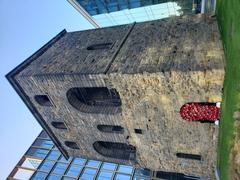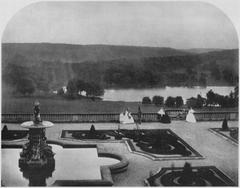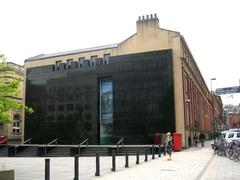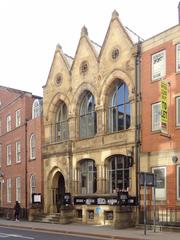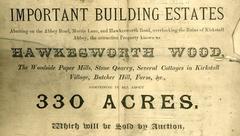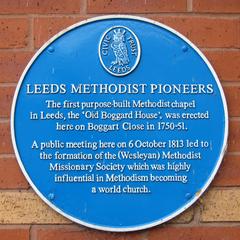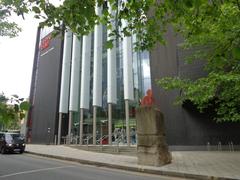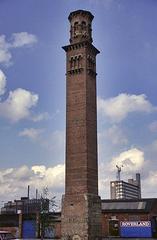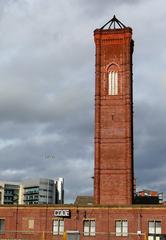
Temple Works Leeds: Visiting Hours, Tickets, and Historical Sites Guide
Date: 04/07/2025
Introduction
Temple Works, located in the historic Holbeck district near Leeds city centre, stands as a remarkable symbol of the United Kingdom’s industrial heritage and architectural innovation. Built between 1836 and 1840, this Grade I-listed former flax mill is celebrated for its Egyptian Revival style—an homage to the temples of Antaeopolis and Horus—making it one of the world’s most unique industrial buildings (Yorkshire Evening Post; Leeds Live). The mill’s innovative features, such as a turf-covered roof for sheep grazing and the world’s first hydraulic lift for livestock, reflect a creative fusion of agriculture and industry.
Historically, Temple Works was integral to Leeds’ prominence in the flax industry, mirroring the city’s rapid industrial rise and the social challenges that accompanied it. The building has experienced decline and periods of vacancy but has since been recognized for its historical and architectural value. Ongoing restoration aims to transform it into the Northern branch of the British Library—a cultural hub that will revitalize Holbeck and contribute to Leeds’ urban regeneration (Leeds City Magazine; West Yorkshire Combined Authority).
While currently closed for restoration, Temple Works is anticipated to reopen with guided tours, special events, and exhibitions that celebrate Leeds’ industrial legacy (Leeds Live). This guide provides a detailed overview of its history, visitor information, and cultural significance.
Table of Contents
- Introduction and Historical Context
- Origins and Architectural Innovation
- Industrial Operations and Social Impact
- Decline, Preservation, and Restoration
- Engineering Innovations
- Industrial Heritage and Legacy
- Restoration Progress and Current Status
- Visiting Information
- Community Regeneration and Economic Impact
- Frequently Asked Questions (FAQs)
- Conclusion and Visiting Tips
- References
Origins and Architectural Innovation
Temple Works was commissioned by John Marshall, a leading figure in Leeds’ flax industry, and designed by engineer James Coombe in an Egyptian Revival style that set it apart from other mills (leedsname.com). Its façade, inspired by the temples of Antaeopolis and Horus, features 18 towering windows, monumental pillars, and an overhanging cornice, all hewn from finely dressed sandstone. The building’s roof was covered in grass to regulate humidity for flax processing, with sheep grazing maintained via the world’s first hydraulic lift for animals (Leeds Live).
The single-story weaving shed—one of the largest of its kind at the time—was illuminated by natural light and ventilated for worker health. Cast-iron columns supported the wide spans, enabling flexible factory layouts (Yorkshire Evening Post).
Industrial Operations and Social Impact
Temple Works opened in 1840, employing over 2,600 workers—many of whom faced harsh industrial conditions. The mill specialized in spinning flax, utilizing a 240-horsepower steam engine to drive hundreds of looms. Social challenges were pronounced: overcrowding, poor sanitation, and low life expectancy were common among factory workers (leedsname.com). In 1871, workers successfully staged a strike for a 10% wage increase, highlighting early labor activism and the site’s role in shaping industrial relations.
Decline, Preservation, and Restoration
By the late 19th century, declining flax demand and competition from cotton led to Temple Works’ closure as a mill. It was later used as a warehouse and fell into disrepair. The original Egyptian-style chimney was demolished in 1852 due to structural instability (Yorkshire Evening Post). Temple Works’ unique architecture gained wider recognition through features in documentaries and art projects.
Recent years have seen significant efforts to restore the building. Over £25 million has been allocated for its transformation into the British Library North, with support from government recovery funds and Historic England (leedsname.com).
Engineering Innovations
Temple Works pioneered several engineering advancements:
- Cast-Iron Construction: The use of cast-iron columns allowed for vast open interiors and improved fire resistance.
- Climate Control: A sophisticated humidification system distributed steam and water vapor to maintain ideal flax-processing conditions.
- Turf Roof: The grass-covered roof provided insulation and humidity regulation, maintained by grazing sheep (elevated via hydraulic lift).
- Fireproofing: Brick vaults and stone walls minimized fire risks—a major concern in textile manufacturing.
These features influenced later factory design and demonstrated that industrial buildings could combine utility with architectural beauty (Rachel Bakewell Artist).
Industrial Heritage and Legacy
Temple Works stands as a symbol of Leeds’ industrial prowess during the 19th century, coinciding with the growth of the Leeds-Liverpool railway and the city’s status as a textile hub (Aireborough Civic Society). Its legacy endures in creative projects and educational initiatives, with ongoing efforts to preserve its unique architectural and historical character.
Restoration Progress and Current Status
Ownership and Restoration
After decades of vacancy and deterioration, Temple Works is now owned by CEG, which collaborates with Leeds City Council and the British Library on a comprehensive restoration plan (Leeds Live). Funding from Historic England, the West Yorkshire Combined Authority, and the Ministry for Housing, Communities, and Local Government supports urgent repairs and long-term redevelopment (Yorkshire Evening Post; Place Yorkshire).
Restoration Timeline
Stabilization of the building’s structure is underway, with phased public access expected as restoration milestones are reached. The ultimate goal is to open an 8,000m² cultural and educational hub that houses exhibitions, research centers, and community spaces (West Yorkshire Combined Authority).
Visiting Information
Visiting Hours
- Current Status: As of July 2025, Temple Works is closed to the public for restoration. Only authorized personnel and project partners have access.
- Future Plans: Upon reopening, expected visiting hours are 9:00 AM to 6:00 PM, Tuesday through Sunday (closed Mondays and public holidays). Special hours may apply during events and festivals.
Tickets and Admission
- General Admission: Anticipated to be free for standard entry.
- Special Exhibitions/Events: May require advance tickets, available online or on-site via the British Library’s website.
Guided Tours and Special Events
Guided tours, open days, and cultural events are planned as restoration phases are completed. These will offer in-depth insights into Temple Works’ architecture, history, and engineering. Group and educational tours may be available by appointment.
Accessibility
Accessibility is a key focus of the redevelopment, with features including step-free entry, accessible restrooms, and hearing support. Visitors with additional needs should consult the venue’s website for detailed information.
Travel Tips
- Location: Holbeck, Leeds, approximately 1.5 miles from Leeds Railway Station.
- Public Transport: Accessible by bus, bike, or a 20-minute walk from city centre. Taxi and parking options are available.
- Nearby Attractions: Explore Armley Mills (Leeds Industrial Museum), Leeds City Museum, Kirkstall Abbey, and the South Bank creative quarter.
Photography and Virtual Tours
The Egyptian Revival façade and restored interiors promise outstanding photographic opportunities. Virtual tours and interactive maps will be hosted on the British Library’s official website.
Community Regeneration and Economic Impact
Temple Works is central to the wider regeneration of Holbeck and Leeds South Bank. Supported by a £10 million government grant and further investments, the project is expected to create jobs, attract visitors, and boost the local economy (Leeds City Magazine; BBC News). It will serve as a cultural anchor, bridging historic divides and providing inclusive access to culture, education, and research (Leeds City Council News).
Programming will include exhibitions, performances, business support, and school engagement, fostering social cohesion and civic pride (Leeds Magazine; Leeds Civic Trust).
Frequently Asked Questions (FAQs)
Q: Is Temple Works open to the public?
A: No, it is currently closed for restoration. Selected areas will reopen as restoration milestones are met.
Q: What are the expected visiting hours?
A: Once open, anticipated hours are 9:00 AM to 6:00 PM, Tuesday through Sunday.
Q: How can I book tickets?
A: General admission is expected to be free. Special events/tours will require advance tickets via the British Library website.
Q: Is Temple Works accessible?
A: Yes, accessibility features will include step-free access, accessible restrooms, and support for visitors with disabilities.
Q: What other attractions are nearby?
A: Armley Mills, Leeds City Museum, Corn Exchange, and the South Bank creative quarter.
Q: Will there be virtual tours?
A: Yes, virtual tours and interactive maps will be available online.
Conclusion and Visiting Tips
Temple Works is a beacon of Leeds’ industrial ingenuity and cultural ambition. Its ongoing restoration and transformation into British Library North signal a new era for this iconic site, promising dynamic public programming, improved accessibility, and a revitalized role in the community. While awaiting full reopening, visitors can explore other historical Leeds attractions and monitor official channels for updates.
To stay informed on reopening dates, ticket releases, and event schedules, download the Audiala app and follow Leeds City Council and the British Library on social media.
References
- Yorkshire Evening Post
- Leeds Live
- leedsname.com
- Leeds City Magazine
- West Yorkshire Combined Authority
- Rachel Bakewell Artist
- Aireborough Civic Society
- SAVE Britain’s Heritage
- Leeds City Council News
- BBC News
- Place Yorkshire
- Leeds Magazine
- Leeds Civic Trust
- Audiala app





